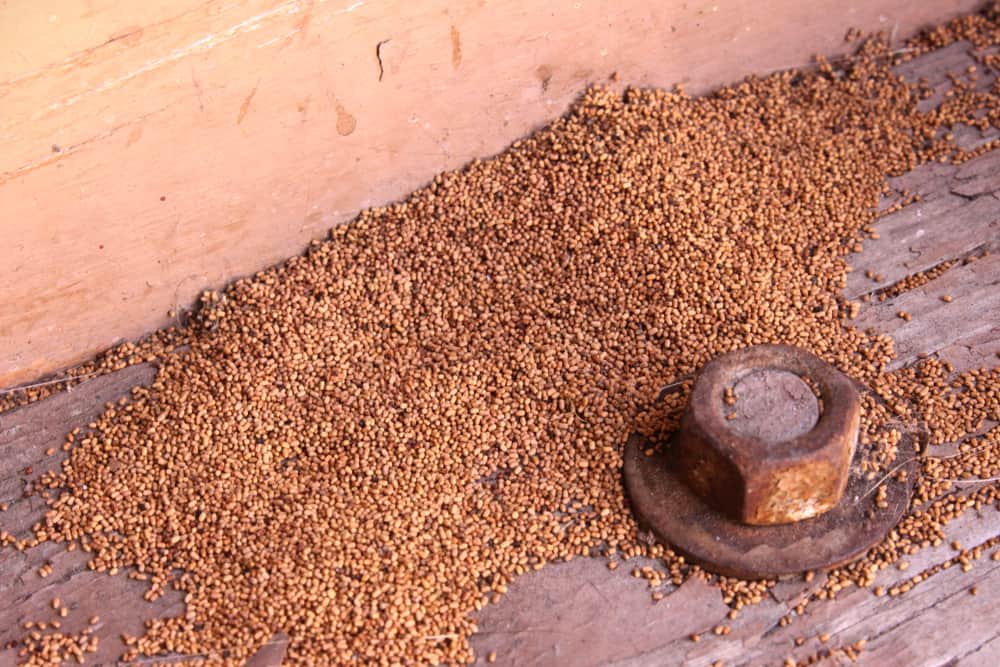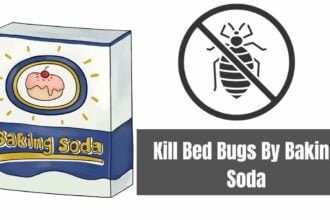Infestations of termites can cause extensive damage to buildings, necessitating expensive repairs and sometimes jeopardizing the safety of the structure. To effectively treat termite infestations and limit any damage, early diagnosis is essential. Termite droppings are one of the most dependable markers of a termite infestation, though there are other signals as well.
Frass is the little, pellet-like feces left behind by termites after they eat wood and other cellulose-based materials. Homeowners can prevent costly structural damage caused by termites by learning to recognize the telltale signs of an infestation and where to check for termite poop.
The look, location, and significance of termite droppings in detecting infestations, and in assisting homeowners in avoiding major termite damage, will all be discussed in this article.
Characteristics of Termite Droppings

1. Appearance and size
Frass, the term used to describe termite droppings, is often a small, elongated pellet, about the size of a grain of sand. Depending on the species of wood being eaten by the termites, their tunnels may be a darker shade of brown or tan. The pellets have a gritty feel and resemble sawdust or coffee grounds in appearance.
2. Pest Droppings vs. Termite Droppings
Termite droppings stand out from those of other pests due to their size and shape. Termite droppings, in contrast to the more irregular shapes and sizes of those left by other pests, tend to be uniformly elongated. In addition, termite droppings are often found in compact mounds, while the droppings of other pests may be dispersed.
The composition of the droppings is another important distinction. The majority of termite feces consists of wood fibers and other plant material, but the feces of other pests may include fragments of food or other items. Last but not least, termite feces may also smell peculiar, which can help confirm the existence of termites.
3. How to Locate Termite Poop
Termite poop is commonly discovered near a wall, floor, or ceiling where termites have recently fed. Also, look for them in or around woodpiles or other sites where termites are known to congregate.
Note that not all termite infestations will result in droppings because different termite species eat wood to different degrees. Yet, the presence of termite droppings is an indication of a possible infestation that needs to be looked at by a pest management expert.
Also See: Find Pest Control Services Near Me
Finding Termite Nests by Analyzing Their Poop
1. How Termite Droppings Indicate Infestation
Frass, or termite droppings, is one of the few visible evidence of termite activity and thus a reliable indicator of a termite infestation. Termites construct galleries and tunnels within the wood, where they live and forage for food.
Droppings are pushed out of the galleries and tunnels as the wood is consumed. A buildup of these feces over time may indicate the existence of active termite activity.
2. Home Termite Droppings
The presence of termite feces is one of the most telltale symptoms of an infestation. Droppings that look like little pellets can be found in locations where termites have been feasting or moving. You might find these droppings in the crevices of your walls or around your windows and doors. They could be lurking up in the roof or down in the basement.
Little holes the size of pinheads in hardwood surfaces are another telltale evidence of termite droppings. Termites make these craters when they expel waste from their galleries and tunnels.
3. Signs of Termite Droppings in the Yard or Surrounding Areas
Homeowners shouldn’t just check for termite poop inside the house; they should also check the yard and other locations. Mud tubes on the outside of the house or in the yard are a common indicator. Termites build these tunnels between their colony and a food source, and their presence may signal an ongoing infestation.
Homeowners may also find abandoned wings near openings in the house’s exterior. Swarmers, the reproductive termites that leave the nest to mate and found new colonies, leave behind their wings. Homeowners may suspect the presence of a colony if they come across swarmers or their shed wings.
Finally, property owners should be aware of any termite-prone trees or wooden constructions in their yards. Termite damage indicators may also be evident, such as pellet mounds or tiny holes the size of pinheads.
The Benefits of Early Detection
1. Reduced Risk of Damage to Property
Reducing the potential for property damage is a major advantage of early termite detection. Termites do extensive damage to buildings over time because they consume wood and other cellulose-based materials for food.
An untreated termite infestation can lead to expensive repairs or possibly total replacement of the afflicted area if left undiscovered. Early termite detection allows homeowners to take action before the infestation worsens.
2. Lowered Costs of Extermination
The costs of eradication can be reduced if a termite infestation is discovered early on. Termites can be difficult and expensive to get rid of if you let their infestation go unchecked for too long.
Early detection of an infestation allows homeowners to save money by avoiding the need for costly measures like fumigation and instead using less invasive methods like localized spot treatments or baiting devices.
3. Prevention of Future Infestations
Early diagnosis of a termite infestation can also assist avoid subsequent infestations. By addressing the issue early and completely, homeowners can eliminate the existing infestation and take action to prevent future infestations from developing.
Repairing any existing damage, fixing any moisture problems, and taking preventative measures like scheduling regular inspections and putting up termite barriers are all possibilities.
Prevention and Treatment
1. Steps to Prevent Termite Infestations
The best way to avoid the destruction brought on by termite infestations is to take preventative measures. Termite infestations can be avoided if homeowners do things like:
- Regular inspections: To detect termite activity early and prevent an infestation from getting established, routine inspections of the home and its surroundings are essential.
- Addressing moisture issues: Since termites are attracted to water, eliminating sources of moisture in the home, such as leaks or standing water, can reduce the risk of a termite infestation.
- Removing wood-to-soil contact: The best way to stop termites from eating your fence posts or deck boards is to either remove them or treat the wood.
- Using termite-resistant materials: Preventing termite infestations can be aided by using pressure-treated wood or steel framing in building or remodeling projects.
- Installing termite barriers: The perimeter of the house can be protected from termites by installing a physical barrier or having it treated with chemicals.
2. Treatment Options for Existing Infestations
There are several solutions for dealing with a termite infestation, depending on the extent of the problem and the species of termites involved. Among these possibilities are:
- Chemical treatments: Termite infestations can be eradicated with the help of chemical treatments like soil-applied termiticides and baiting systems.
- Heat treatments: Termites can be killed using localized heat treatments in places like furniture and wall cavities.
- Fumigation: A more in-depth method, fumigation entails closing the house and releasing gas to kill any termites within.
- Wood replacement: Fumigation is a more thorough approach, involving the sealing of the home and the release of gas to destroy any and all termites inside.
3. Importance of Professional Extermination
Infestations of termites are best treated by a professional exterminator. Pest control technicians are equipped with the expertise to diagnose the species of termites, the extent of the infestation, and the best course of action to eliminate the problem.
In addition, hiring a professional exterminator is the best way to lessen the likelihood that you or your family’s pets would be harmed by the treatments. If a homeowner discovers or suspects a termite infestation, they should immediately seek the services of a qualified pest management company.







